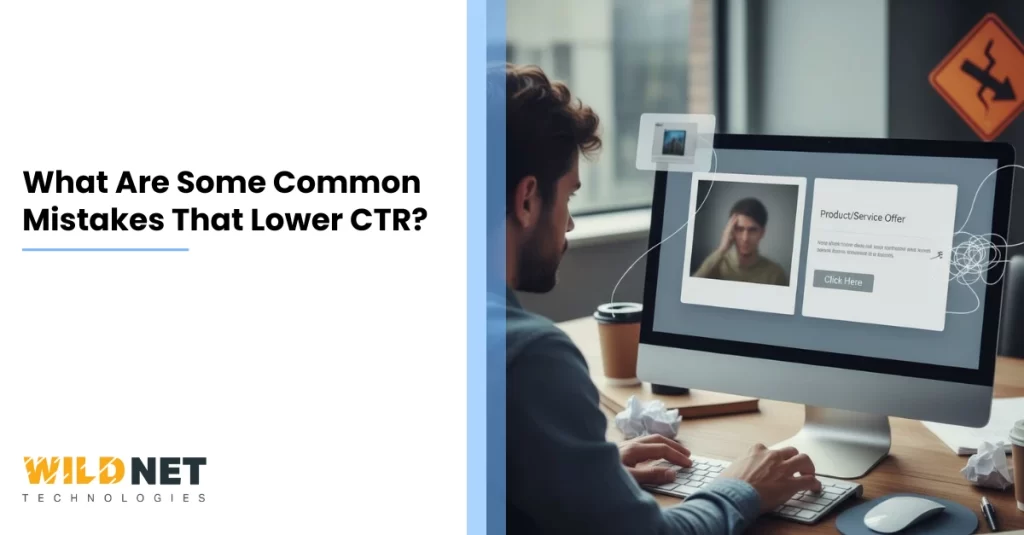Summary
Branding in SERP Google is crucial because it shapes how users and Google perceive your brand. A strong brand presence builds trust, boosts clicks, improves SEO, and protects reputation, helping businesses stand out, gain authority, and drive conversions in today’s search-driven, brand-centric digital world.
Key takeaways
- Users trust brands; brands get clicked.
- Google evaluates signals that strong brands tend to have.
- Branded search traffic has higher intent and value.
- Your brand SERP is your digital first impression.
Table of Contents
- Introduction
- A Few Facts
- What exactly is branding in SERP Google?
- Why is branding in SERP Google a big thing?
- How does branding in SERP Google show up (what should you watch for?)
- The benefits you’ll enjoy from strong branding in SERP Google
- What happens when you don’t pay attention to branding in SERP Google?
- How to build & optimize your branding in SERP Google
- Common mistakes & misconceptions to avoid
- The future of branding in SERP Google
- Final thoughts
- FAQs
Introduction
Ever typed your brand’s name into Google and saw what comes up? Well, there’s more to it than just your brand appearing. It’s called ‘brand in search moment’.
This is an important moment. We’re talking about branding in the SERP Google.
It’s about how your brand appears in Google’s search results pages. Now, why is that a big deal?
You might think –
“Is this just about logos and colour palettes?”
Not really. It’s about how your brand shows up, how users perceive it, how Google recognizes and treats it, and how all of that affects your visibility, traffic, trust and business growth.
When done right, good branding in the SERP makes your brand stand out, get clicked, get trusted, and get chosen.
We, as the best digital marketing services provider, are here to help you get a better understanding of branding is SERP Google. So, let’s get into it.
A Few Facts
- Around 45.7% of all Google searches include a brand name or product brand (Ahrefs)
- The fifth pillar of SEO is brand awareness. ( Search Engine Journal)
- More than six in ten brands whose brand-SERP includes a PAA panel haven’t answered any of the questions themselves. (SearchEngineLand)
What exactly is branding in SERP Google?
When people search on Google, the search results page (SERP) they see shows a mix of things. It shows your website, links, maybe a knowledge panel, images, videos, “People also ask” boxes, social profiles, reviews, news items, etc.
Now, when the search is about your brand (or what your brand does) or even if a person types a generic query, but your brand is relevant, what shows up for your brand (and how) is your brand’s presence in that SERP.
So branding in SERP Google means how your brand appears and performs in Google Search results, including how visible you are, how recognizable you are, how trusted you look, and how well you dominate that search footprint.
Why is branding in SERP Google a big thing?
Now onto the “why”. Why should you care about branding in the SERP? The answer: Because it drives outcomes. Below are the key reasons.
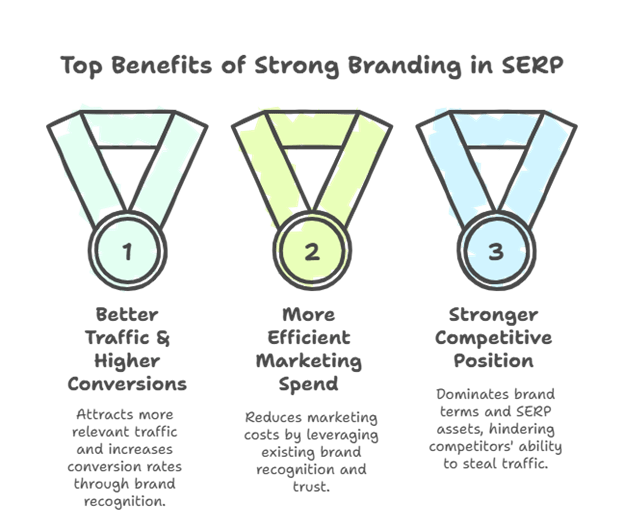
Key features enhancing brand presence in SERP
Users trust brands
People tend to click results for brands they know or recognize. Google “prefers brands” because they signal trust, authority and good user experience. For example, if you search “best running shoes”, users are more likely to click a result from a known brand than from a random site.
Also, research by Ahrefs found that nearly 45.7% of all Google searches are branded searches, meaning people type in brand names often.
So when your brand is visible and positive in the SERP, you benefit from that built-in trust, and you capture more clicks.
Google rewards recognizable brand signals
Google’s algorithms don’t explicitly say that brands will be ranked higher. Still, many signals associated with strong brands align with signals Google likes. Relevance, authority, good user experience, links, and mentions are some of them.
Higher click-through rates (CTR) & better user engagement
If your brand is recognizable and appears prominently, users will be more comfortable clicking your result. That means higher CTR.
Branded search traffic is high-value
Branded queries tend to be lower in the funnel. People already know the brand and maybe are closer to conversion. As the article in Search Engine Journal states:
“Branded search traffic … has higher commercial intent and a higher conversion rate.”
Therefore, when your branding in SERP Google is strong, you’re more likely to capture this valuable traffic.
More search real-estate & “ownership”
Good branding means you don’t just occupy the #1 organic link, but also multiple spots, such as on social profiles, branded pages, video results, images, sitelinks, and knowledge panels.
Reputation & risk mitigation
When your brand appears clearly and has good credibility in the SERP, you’re better prepared for negative content or PR issues. If you’ve already built a strong footprint, then an unfavourable article will have less relative impact.
Competitive advantage & barrier to entry
Smaller brands or startups often struggle to rank because they lack brand awareness, trust signals, mentions, and links with bigger players. Google tends to favour brands because user experience is typically more predictable.
It’s becoming more important in evolving search
With generative AI, voice search, conversational results and entity-based search becoming more prominent, brand signals are increasingly valuable.
How does branding in SERP Google show up (what should you watch for?)?
We’ve looked at why, now let’s look at how branding in the SERP plays out. What are the tangible features and signals you’ll see (or should aim for)?
Branded query results (Brand SERP)
When someone searches your exact brand name (or a close variant), the results they get are your Brand SERP.
SERP features that support brand presence
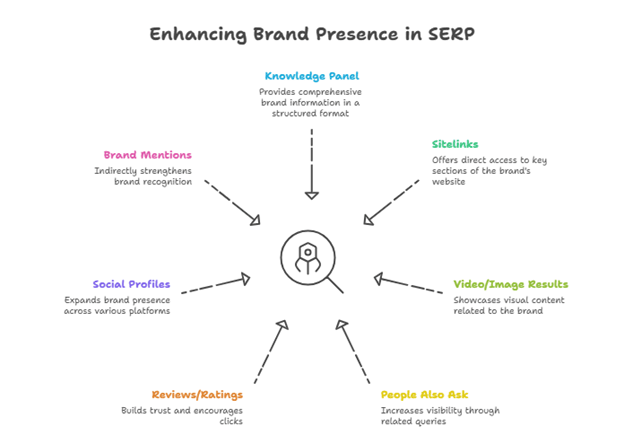
Key features enhancing brand presence in SERP
Various features in the SERP can help strengthen your branding in search:
- Knowledge panel: If Google recognizes your brand as an entity, you may get a panel with your brand name, logo, summary, links.
- Sitelinks: When Google shows multiple links under your main result (e.g., “About”, “Services”, “Blog”) this boosts visibility and signals a mature brand site.
- Video / image results: If you have a YouTube channel or strong image assets, Google may show video carousels or image packs for branded queries.
- “People Also Ask” and related queries: If your brand is associated with key topics, you may show up in these sections, thereby increasing visibility.
- Reviews / ratings / star snippets: Especially for local or e-commerce brands, review stars boost trust and click likelihood. If you need online reputation management services, get in touch with Wildnet today.
- Social profiles & other domains: Having your brand show in multiple domains (LinkedIn, Twitter, Facebook, etc) further boosts visibility.
- Items like “branded searches volume,” brand mentions (even without links): These are indirect but powerful signals that Google uses to assess your brand strength.
Signals behind the scenes
Beyond what you see, Google uses many underlying signals tied to brand strength:
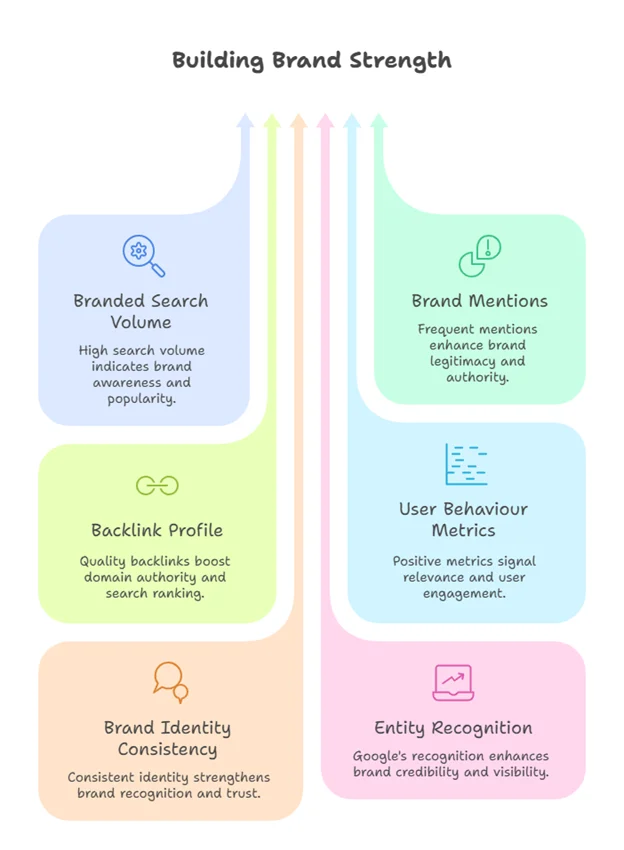
Signals behind branding in Google SERP
- Branded search volume: If many users search your brand name, that indicates you’re known.
- Brand mentions (unlinked and linked): When your brand is talked about across the web, even without a link, Google sees this as a citation / signal of legitimacy.
- Backlink profile / domain authority: Brands often accumulate more, better quality links which bolster authority.
- User behaviour metrics: CTR, bounce rate, dwell time — strong brands often perform better here, which in turn signals relevance.
- Consistency of brand identity across web (logo, colours, messaging, NAP for local): This helps Google recognize you as a single entity.
- Entity recognition: When Google recognizes your brand as a distinct entity in its knowledge graph, your brand benefit increases.
- Off-site vs on-site brand signals: Social presence, press coverage, citations, directories all reinforce your brand footprint.
The benefits you’ll enjoy from strong branding in SERP Google
Now that we’ve got the how and the why, let’s talk about the benefits you’ll actually see when you invest in branding in the SERP.
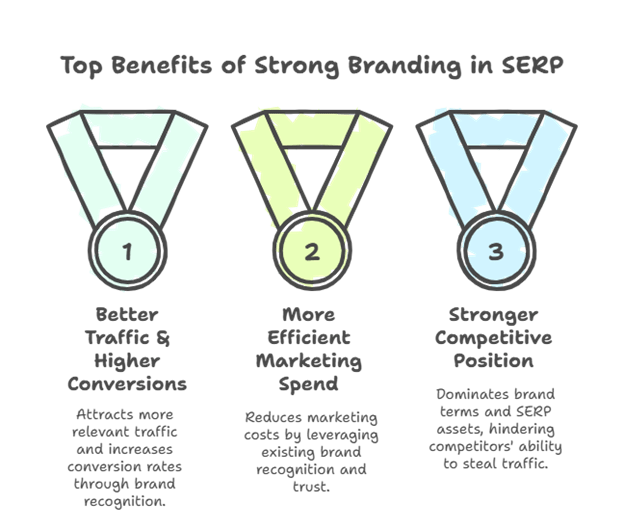
Top benefits of strong branding in SERP
Better traffic & higher conversions
When your brand appears strongly in SERP, you attract more of the right kind of traffic. Because your brand is recognized, users are more likely to click when they see you, and more likely to trust what they find, which leads to higher conversion rates.
More efficient marketing spend
When your brand footprint is strong, you may spend less on chasing awareness from scratch. You’ll rely more on people who already know or recognize your brand. That makes acquisition cheaper and retention easier.
Stronger competitive position
If you dominate your brand term and appear in multiple SERP assets (videos, images, social, etc), you make it tougher for competitors or aggregators to steal your traffic or present themselves as the authority.
Better resilience & reputation control
A well-built brand in the SERP means you have more control over what people see. If something bad happens (negative press, complaint), you already have positive assets dominating your brand page, so the damage is mitigated.
Improved non-brand ranking too
Interestingly, brands that dominate their brand terms often benefit when ranking for non-brand keywords too. Because many of the signals (authority, trust, mentions, brand awareness) overlap. So branding in SERP Google helps overall SEO, not just brand terms.
Future-proofing for search evolution
As search evolves into voice, generative AI, entity search, your brand footprint in SERP becomes a key asset. Being “known” and “trusted” helps you show up in these newer modalities. For example, Google may extract your brand as the answer to a question, if you have strong entity signals.
What happens when you don’t pay attention to branding in SERP Google?
It’s equally important to consider the downside of neglecting your brand’s SERP presence.
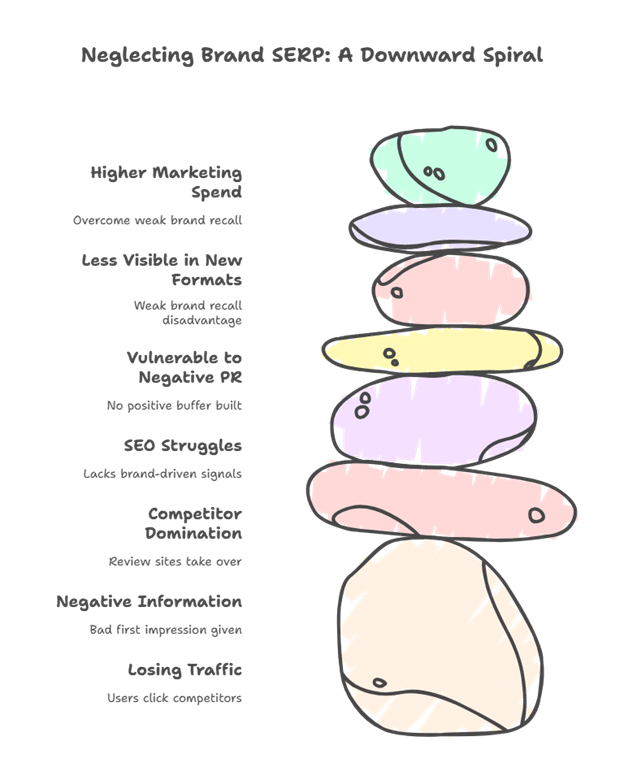
What happens when you neglect branding
- You might be losing traffic: if your brand is weak in search, users may click competitors instead of you.
- Your brand SERP might show outdated, negative or irrelevant information, giving a bad first impression.
- Competitors or review sites might dominate your branded query results.
- Your SEO for generic keywords might struggle because you lack the underlying brand-driven signals.
- You may be more vulnerable to negative PR or one bad piece of content, since you haven’t built a strong “positive buffer” in search.
- As search evolves, lack of brand strength may make you less visible in new formats (voice, AI search features).
- Your marketing spend may have to be higher to overcome the disadvantage of weak brand recall.
How to build & optimize your branding in SERP Google
Okay, time to get practical. Here’s a guide you can act on to strengthen your branding in the SERP.
Step 1: Audit your Brand SERP
Start by searching your brand name (and variations, misspellings) in Google (use incognito or logged-out). Ask:
- Does your homepage appear in the #1 spot?
- Are there sitelinks?
- Is there a knowledge panel?
- What other pages dominate? Are there negative results or irrelevant sites?
- How many searches are branded (you can use tools like Google Trends)?
- This audit gives you the baseline.
Step 2: Clarify your brand identity
Make sure you have a clear brand story: What you do, why you exist, who you serve. Ensure your website’s “About” page, “Home” page reflects this clearly. Also ensure your brand name is used consistently (same spelling, logo, voice) across channels.
Step 3: On-site optimization for brand
- Use your brand name in your title tags, meta descriptions where relevant.
- Implement structured data: Organization / Brand schema so Google recognizes your entity.
- Ensure your homepage loads fast, is mobile-friendly, good user experience (brands are expected to deliver).
- Create content (blog posts, resources) that align with your brand’s topic area, so you build relevance.
- Ensure your website architecture is clear, with good internal linking to substantiating pages (About, Services, Blog).
- Use a clear logo and consistent design theme (as these are brand signals).
Step 4: Off-site brand signals
- Build backlinks from reputable sites. Brands tend to attract more organic links.
- Monitor brand mentions (even if no link). Your name appearing across the web counts as a signal.
- Develop active social profiles (LinkedIn, Twitter/X, Instagram, Facebook) to widen brand footprint.
- Ensure consistent NAP (Name, Address, Phone) if you have local presence (local SEO).
- Encourage positive reviews/testimonials (especially for local or e-commerce businesses).
Step 5: Content & brand visibility
- Create content that is helpful, targeted to your audience, and aligned with your brand’s niche.
- Explore video content marketing and image content. Good brands show up in video/image SERP features.
- Build your brand associations. When you publish press, guest posts or partnerships, link your brand to the topics your audience cares about.
Step 6: Continuously monitor & manage your brand SERP
- Use tools to track your brand’s SERP: how many results you dominate, what appears above you, what changes over time.
- Monitor for negative content: bad reviews, outdated pages, competitor takeover.
- Re-audit quarterly (or more often) to ensure your brand SERP remains strong.
- Pay attention to new SERP features (e.g., AI overviews, voice search) and adapt your brand’s presence accordingly.
Step 7: Make your brand an “entity”
Brands that Google recognizes as entities gain extra benefits (knowledge panel, brand trust). Steps include:
- Ensure consistent usage of your brand name across the web.
- Use structured data (Brand, Organization).
- Create or update your Google Business Profile (if applicable).
- Get your brand listed in trustworthy directories/citations.
- Encourage high-quality mentions in press or authoritative sites.
Common mistakes & misconceptions to avoid
As you build your branding in SERP Google, watch out for these pitfalls.
Mistake 1: “Branding doesn’t matter for SEO”
You might hear “Google doesn’t favour brands”. While it’s true Google says it doesn’t explicitly rank brands because they’re brands, what matters is that brand signals (trust, mentions, backlinks, user behaviour) do matter.
Mistake 2: Only focusing on non-brand keywords
There’s often a heavy focus on “best X”, “how to Y” etc. (non-brand). But branded queries (brand name + product/service) are valuable and often overlooked. As noted earlier, nearly half of searches are branded. So ignoring branded search means leaving a big opportunity on the table.
Mistake 3: Assuming your brand edition is done
Some brands assume once they have a logo and website, they’ll automatically rank for their brand name. But the brand SERP can fluctuate (e.g., competitors, review sites, changes in Google’s features).
Mistake 4: Treating branding and SEO separately
Branding in the SERP is not just marketing and not just SEO, it’s the intersection. Too often, SEO teams work on keywords and links, and branding teams work on brand awareness, not enough overlap. A unified approach is better.
Mistake 5: Neglecting user experience and trust
Having a brand name doesn’t excuse weak UX, slow site, poor content. Google still cares about experience. So if your site is slow, mobile-unfriendly or confusing, you hurt your brand SERP.
The future of branding in SERP Google
Looking ahead, branding in the SERP is poised to become even more important. Here’s why:
Entity and Knowledge Graph search
Search is shifting from keywords to entities. Brands that are recognized entities by Google will benefit from knowledge panels, better visibility and more trust. The more your brand is seen as a discrete entity, the stronger your brand SERP.
Voice & AI search
With voice assistants and generative AI becoming common, users are less likely to click a long list of search results. They want trusted sources and quick answers. If your brand is recognized and trusted, you’re more likely to be used as a cited answer by an AI.
Visual & multimedia search formats
Image search, video search, and carousels are important and brands that invest in these formats will dominate more SERP real estate. The “On-SERP SEO” concept emphasizes controlling multiple assets.
More crowded SERP real-estate
As Google adds more SERP features (news, videos, shopping, local packs, AI panels), seeing your brand only as the #1 link is no longer enough. You need to show across multiple assets for branding in SERP Google to truly shine.
Offline branding and search interplay
Offline ads (billboards, TV, radio) can trigger branded searches online. This interplay means branding in SERP Google is not just digital; it connects to your overall brand marketing.
Final thoughts
Branding in SERP Google is a big deal because it sits at the intersection of branding, search, trust and conversion. It’s where your brand meets the user’s first impression via search. If you show up, look credible, get clicked, and deliver, you win. If you don’t, you risk being ignored, mis-represented, or left behind.
If you’re looking for a company that not just offers SEO services but also takes care of your branding in SERP Google, connect with us at Wildnet Technologies today.
For over 19 years, Wildnet Technologies has been a trusted leader in AI-powered digital marketing, helping more than 4,100 clients achieve remarkable business growth.
Read More
Liked what you were reading? Check out more of our blogs:
- How Gen Z Brand Loyalty is redefining Branding & Marketing?
- What Are The Types Of Branding?
- Branding vs. Marketing in 2025
- Do Google Reviews Help SEO?
FAQs
Question 1. What exactly is “branding in SERP Google”?
Answer. It’s the way your brand appears on the search results page when someone types your brand name (or a query related to your brand) into Google. This includes your website’s listing, sitelinks, social profiles, images, videos, knowledge panels, reviews, and other signals.
Question 2. Why does branding in SERP Google matter so much?
Answer. Because the first page of Google is often the first impression people get of your brand. If your brand shows up clearly, authoritatively and positively you build trust, attract more clicks, and reinforce your credibility.
Question 3. How do I improve my branding in SERP Google?
Answer. Here are key steps:
- Make sure your website uses your brand name clearly in titles, headings and meta descriptions.
- Use structured data (e.g., schema.org “Brand” or “Organization”) so Google understands your brand as an entity.
- Build a consistent web presence: social profiles, reviews, press mentions, blog content.
- Monitor your “brand + query” results in Google: Check what appears above and around your brand search.
- Create useful content that answers common questions around your brand (so you can show up in features like “People Also Ask”).
Question 4. If I search my brand name and I rank first, do I still need to worry about branding in SERP?
Answer. Yes, ranking first is good, but it’s not the whole picture. Your brand SERP also includes what appears around your brand: other links, questions people ask, featured snippets, reviews, images, etc. For example, even if you’re #1, someone else might dominate the “People Also Ask” section for your brand, or negative articles might show up.
Question 5. How long does it take to see results when working on branding in SERP Google?
Answer. There’s no fixed timeline, it depends on your niche, brand awareness, competition and how many signals you already have. Some improvements (like fixing your metadata or implementing structured data) can show quick wins within weeks. Others (like building brand mentions, gaining trust and dominating brand search real-estate) may take several months. The key is consistent effort, monitoring your brand SERP, and refining your strategy over time.




